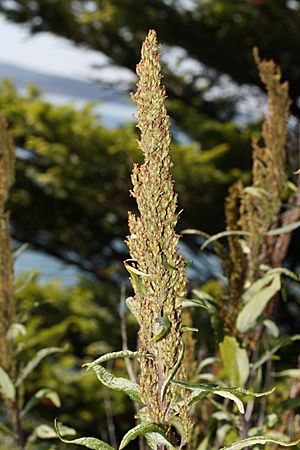Artemisia suksdorfii facts for kids
Quick facts for kids Artemisia suksdorfii |
|
|---|---|
 |
|
| Scientific classification | |
| Genus: |
Artemisia
|
| Species: |
suksdorfii
|
| Synonyms | |
|
|
Artemisia suksdorfii is a type of sagebrush that belongs to the sunflower family. It has a few common names, like coastal mugwort and coastal wormwood. You can also call it Suksdorf sagewort. This plant grows naturally along the coasts of North America.
About Coastal Mugwort
Coastal mugwort is found in coastal areas from British Columbia in Canada, all the way down to northern California in the United States. It grows in states like Washington and Oregon. You can even find some isolated groups of these plants on Santa Catalina Island in Los Angeles County.
Where It Lives
This plant loves to grow near the ocean. You will often find it in coastal drainage areas. These are places where water flows from the land towards the sea. It thrives in the unique conditions found close to the coast.
What It Looks Like
Artemisia suksdorfii is a rhizomatous perennial herb. This means it's a plant that lives for many years. It has special underground stems called rhizomes. These rhizomes help the plant spread and grow new shoots.
- It produces many straight stems that can grow from about half a meter to two meters tall.
- The stems are brownish and have woody bases, making them quite strong.
- Its leaves are narrow and have lobes, which are rounded parts.
- The top of the leaves is green and smooth, without hairs.
- The underside of the leaves is white and feels soft, like wool.
The plant's inflorescence is usually shaped like a spike. An inflorescence is the way flowers are arranged on a plant. This spike can be up to 30 centimeters long. It holds many small clusters of flower heads. These flower heads have shiny yellow-green phyllaries. Phyllaries are like small leaves that protect the flower head. The actual flowers, called florets, are yellow.
After the flowers, the plant produces tiny fruits. These fruits are called achenes. An achene is a small, dry fruit that contains one seed. Each achene is less than a millimeter long.
Why the Name Suksdorf?
The plant Artemisia suksdorfii is named after a German-American botanist. His name was Wilhelm Nikolaus Suksdorf. He lived from 1850 to 1932. Botanists are scientists who study plants. Naming plants after the people who discover or study them is a common way to honor their work.
See also
 In Spanish: Artemisia suksdorfii para niños
In Spanish: Artemisia suksdorfii para niños

